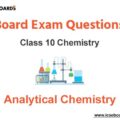Question 1: Write the probable colour of the following salts.
(a) Ferrous salts
(b) Ammonium salts
(c) Cupric salts
(d) Calcium salts
(e) Aluminium salts
Solution 1:
(a) Ferrous salts : Light green
(b) Ammonium salts : Colourless
(c) Cupric salts : Blue
(d) Calcium salts : Colourless
(e) Aluminium salts : Colourless
Question 2: Name:
(a) A metallic hydroxide soluble in excess of NH4OH.
(b) A metallic oxide soluble in excess of caustic soda solution.
(c) A strong alkali
(d) A weak alkali
(e) Two coloured metal ions
(f) Two coloured metal ions
(g) A metal that evolves a gas which burns with a pop sound when boiled with alkali solutions.
(h) Two bases which are not alkalis but dissolves in alkalis to yield colourless solutions.
(i) A coloured cation not a representative element.
Solution 2:
(a) A metallic hydroxide soluble in excess of NH4OH. = Cu(OH)2
(b) A metallic oxide soluble in excess of caustic soda solution. = ZnO
(c) A strong alkali = NaOH
(d) A weak alkali = NH4OH
(e) Two coloured metal ions = Na+, Ca2+
(f) Two coloured metal ions = Fe2+,Mn2+
(g) A metal that evolves a gas which burns with a pop sound when boiled with alkali solutions. = Aluminium
(h) Two bases which are not alkalis but dissolves in alkalis to yield colourless solutions. = Zn(OH)2 and Al(OH)3
(i) A coloured cation not a representative element. = Ammoniumion
Question 3: Write balanced equations for Q.2 (g) and (i)
Solution 3:
Balanced Equations:
(g) 2Al + 2NaOH + 2H2O ⟶ 2NaAlO2 + 3H2
(Hot and conc.) Sodium metaaluminate
(colourless)
(i) PbO + 2NaOH ⟶ Na2PbO2 + H2O
(Yellow) Sodium plumbate
(colourless, solubl
Question 4: What happens when ammonia solution is added first drop wise and then in excess to the following solution:
(i) CuSO4 (ii) ZnSO4 (iii) FeCI3
Write balanced equations for these reactions.
Solution 4:
(i) CuSO4 + 2NH4OH ⟶ Cu(OH)2 + (NH4)2SO4
Blue pale blue ppt. colourless is solution
With excess of NH4OH, ppt dissolves
CU(OH)2 + (NH4)2SO4 + 2NH4OH ⟶ [Cu(NH3)4]SO4 + 4H2O
(ii) ZnSO4 + 2NH4OH ⟶ Zn(OH)2 + (NH4)2SO4
Colourless white,gelatinous ppt colourless
With excess of NH4OH, ppt dissolves
Zn(OH)2 + (NH4)2SO4 + 2NH4OH ⟶ [Zn(NH3)4]SO4 + 4H2O
(excess) Tetramminezinc (II) Sulphate
(colourless)
(iii) FeCI3 + 3NH4OH ⟶ Fe(OH)3 ↓ +3NH4CI
Yellow solution reddish brown ppt. colourless in solution
Question 5: What do you observe when caustic soda solution is added to the following solution, first a little and then in excess:
(a) FeCI3
(b) ZnSO4
(c) Pb(NO3)2
(d) CuSO4
Write balanced equations for these reactions.
Solution 5:
(i) FeCI3 + 3NaOH ⟶ Fe(OH)3 ↓ 3NaCI
Yellow r eddish brown, ppt colourless in solution
In excess of alkali, the reddish brown ppt, of Fe(OH)3 remains in soluble
(ii) ZnSO4 + 2NaOH ⟶ Zn(OH)2 ↓ + NaSO4
Colourless white gelatinous ppt. colourless
In excess of alkali, white gelatinous ppt. of Zn(OH)2 becomes soluble
Zn(OH)2 + 2NaOH(Excess) ⟶ Na2ZnO2 + 2H2O
Sodium zincate (colourless)
(iii) Pb(NO3)2 + 2NaOH ⟶ Pb(OH)2 ↓+ 2NaNO3
White ppt (colourless)
In excess of alkali, white precipitate of Pb(OH)2 becomes soluble:
Pb(OH)2 + 2NaOH(excess) ⟶ Na2PbO2 + 2H2O
Sodium plumbate
{colourless}
CuSO4 + 2NaOH ⟶ Cu(OH)2 ↓ + 2NaSO4
Blue colourless pale blue ppt. colourless
In excess of alkali, pale blue precipitate of Cu(OH)2 is insoluble.
Question 6: Name the chloride of a metal which is soluble in excess of ammonium hydroxide. Write equation for the same.
Solution 6:
Zinc chloride (ZnCl2) is soluble in excess of ammonium hydroxide.
ZnCI2 + 2NH4OH ⟶ Zn(OH)2 ↓ 2NH4CI
Colourless White gelatinous ppt.
With excess of NH4 OH ppt dissolves
Zn(OH)2 + 2NH4CI + 2NH4OH(excess) ⟶ [Zn(NH3)4]CI2+ 4H2O
Tetram mine zinc (II) Chloride Colourless
Question 7: On adding diluteammonia solution to a colourless solution of a salt, a white gelatinous precipitate appears. This precipitate however dissolves on addition of excess of ammonia solution identify (choose from Na, Al, Zn, Pb, Fe)
(a) Which metal salt solution was used?
(b) What is the formula of the white gelatinous precipitate obtained?
Solution 7:
(a) ZnCl2
(b) Zn(OH)2
Question 8: Name:
(a) a yellow monoxide that dissolves in hot and concentrated caustic alkali
(b) a white, insoluble oxide that dissolves when fused with caustics odor caustic potash
(c) a compound containing zinc in the anion
Solution 8:
(a) PbO
(b) ZnO
(c) K2ZnO2
Question 9: What do you observe when freshly precipitated aluminium hydroxide reacts with caustic soda solution? Give balanced equation.
Solution 9:
(a) (iii)
Aqueous solution of copper sulphate is blue.
(b) (iii)
FeSO4 + 2NaOH → Fe(OH)2 + Na2SO4
Dirty green, (Colourless) gelatinous ppt.)
(c) (iii)
Zn + 2NaOH → Na2ZnO2 + H2
Sodium zincate (Colourless)
Zn + HCl → ZnCl2 + H2
Question 10: What do you understand by amphoteric oxide. Give the balancd equations for the reaction with three different amphoteric oxides with a caustic alkali. Write you observation if any.
Solution 10:
When freshly precipitated aluminum hydroxide reacts with caustic soda solution, white salt of sodium meta aluminate is obtained.
Al(OH)3 + NaOH → NaAlO2 + 2H2O
Sodium meta aluminate
Question 11: Distinguish by adding:
(a) Sodium hydroxide solution and
(b) Ammonium hydroxide solution to
(i) Calcium salt solution and lead salt solution
(ii) Lead salt solution and ferrous salt solution
(iii) Copper salt solution and ferrous salt solution
(iv) Fe (II) salt solution and Fe (III) salt solution
(v) Ferrous nitrate and lead nitrate
Solution 11:
(a) Distinguish by adding Sodium hydroxide solution and :
(i) Ca(NO3)2 + 2NaOH → Ca(OH)2 + 2NaNO3
On adding excess of NaOH, ppt. of Ca (OH)2 is sparingly soluble.
Pb(NO3)2 + 2NaOH → Pb(OH)2 + 2NaNO3
On adding excess of NaOH, ppt of Pb(OH)2 is soluble.
(ii) Pb(NO3)2 + 2NaOH → Pb(OH)2 + 2NaNO3
On adding excess of NaOH, ppt of Pb(OH)2 is soluble.
ZnSO4 + 2NaOH → Zn(OH)2 + Na2SO4
With excess of NaOH, white gelatinous ppt. of Zn (OH)2 is soluble. So, these two cannot be distinguished by NaOH alone. However white ppt. of Pb (OH)2 is readily soluble in acetic acid also.
(iii) CuSO4 + 2NaOH → Cu(OH)2 + Na2SO4
With excess of NaOH, alkali pale blue ppt of Cu (OH)2 is insoluble.
FeSO4 + 2NaOH Fe(OH)2 + Na2SO4
With excess of NaOH, dirty green ppt. of Fe(OH)2 is insoluble.
(iv) FeSO4 + 2NaOH → Fe(OH)2 + NaSO4
With excess of NaOH, dirty green ppt of Fe (OH)2 is insoluble.
FeCl3 + 3NaOH → Fe(OH)3 + 3NH4Cl
With excess of NaOH, reddish brown ppt of Fe (OH)3 is insoluble.
(b) Distinguish by adding Ammonium hydroxide solution:
(i) On addition of NH4OH to calcium salts no precipitation of Ca (OH)2 occurs even with addition of excess of NH4OH because the concentration of OH-ions from ionization of NH4OH is so low that it cannot precipitate the hydroxide of calcium.
Pb(NO3)2 + 2NH4OH → Pb(OH)2 + 2NH4NO3
On adding excess of NH4OH, chalky white ppt. of Pb (OH)2 is insoluble.
(ii) Pb(NO3)2 + 2 NH4OH → Pb(OH)2 + 2NH4NO3
On adding excess of NH4OH, chalky white ppt. of Pb(OH)2 is insoluble.
ZnSO4 + 2NH4OH → Zn(OH)2 + (NH4)2SO4
With excess of NH4OH, white gelatinous ppt. of Zn (OH)2 is soluble.
(iii) CuSO4 + 2NH4OH → Cu(OH)2 + (NH4)2SO4
With excess of NH4OH, pale blue ppt. of Cu (OH)2 is soluble.
FeSO4 + 2NH4OH → Fe(OH)2 + (NH4)2SO4
With excess of NH4OH, dirty green ppt. of Fe (OH)2 is insoluble.
(iv) FeSO4 + 2NH4OH → Fe(OH)2 + (NH4)2SO4
With excess of NH4OH, dirty green ppt. of Fe (OH)2 is insoluble.
FeCl3 + 3NH4OH Fe(OH)3 + 3NH4Cl
With excess of NH4OH, reddish brown ppt of Fe (OH)3 is insoluble.
Question 12: You are provided with two reagent bottles marked A and B. One of which contains NH4OHsolution and the other contains NaOH solution. How will you identify them by a chemical test?
Solution 12:
Calcium salts such as Ca(NO3)2 can be used to identify reagent bottles A and B.
When NaOH is added to Ca (NO3)2, Ca (OH)2 forms a white precipitate that is only sparingly soluble in excess NaOH.
Ca(NO3)2 + 2NaOH ->Ca(OH)2+ 2NaNO3
When NH4OH is added to calcium salts, no Ca(OH)2 is precipitated, even when there is an excess of NH4OH, because the concentration of OH-ions produced by the ionization of NH4OH is so low that it cannot precipitate the calcium hydroxide.
The NaOH reagent bottle produces white precipitate, while the NH4OH reagent bottle produces yellow precipitation.
Intext Questions:
Question 1: What do you understand by the following:
(i) Analysis
(ii) Qualitative analysis
(iii) Reagent
(iv) Precipitation
Solution 1:
(i) Analysis: Analysis is the process of determining the chemical components of a sample.
(ii) Qualitative analysis: Qualitative analysis is a type of analysis that involves identifying unknown chemicals in a sample.
(iii) Reagent: A reagent is a chemical that reacts with another chemical.
(iv) Precipitation: Precipitation is the production of an insoluble solid when two or more solutions are combined together. Precipitate is the solid that results from this process.
Question 2: Write the probable colour of the following salts:
(i) Iron(III)chloride
(ii) Potassium nitrate
(iii) Ferrous sulphate
(iv) Aluminium acetate
(v) Calcium carbonate
Solution 2:
(i) Yellow
(ii) Colourless
(iii) Pale Green
(iv) Colourless
(v) Colourless
Question 3: Name the probable cation present in each of the following solution:
(i) Yellow coloured solution
(ii) Blue coloured solution
(iii) Light blue coloured solution
(iv) Pink coloured solution
Solution 3:
1. Fe3+
2. Cu2+
3. Cu+2
4. Mn2+
Question 4: Name the metal hydroxides which are:
(i) Sparingly soluble
(ii) Insoluble
(iii) Soluble
In caustic soda solution
Solution 4:
(i) Ca(OH)2
(ii) Fe(OH)2 and Cu(OH)2
(iii) Zn(OH)2 and Pb(OH)2
Question 5: What do you observe when ammonium salt is heated with caustic soda solution? Write the balanced equation.
Solution 5:
Ammonia gas is produced when ammonium salt is heated with caustic soda solution. The balance equation is as follows:

Question 6: How will you distinguish NH4OH solution from NaOH solution?
Solution 6:
Calcium salts can be used to distinguish between NH4OH and NaOH.
When NaOH is added to Ca(NO3)2, Ca(OH)2 forms a white precipitate that is only sparingly soluble in excess of NaOH.
Ca(NO3)2 + 2NaOH → Ca(OH)2 + 2NaNO3
There is no precipitation of Ca(OH)2 when NH4OH is added to calcium salts, even if there is an excess of NH4OH. This is due to the low concentration of OH- ions produced by the ionisation of NH4OH, which prevents the calcium hydroxide from precipitating.
Question 7: Name the metal hydroxides which are:
(i) Insoluble
(ii) Soluble.
In ammonium hydroxide solution.
Solution 7:
(i) Fe(OH)2 and Pb(OH)2
(ii) Cu(OH)2 and Zn(OH)2




